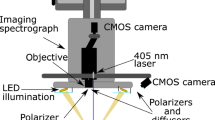Abstract
Near infrared spectroscopy (NIR) and skin impedance (IMP) spectroscopy are two methods suggested for diagnoses of diseases inducing adverse effects in skin. The reproducibility of these methods and their potential value in non-invasive diagnostics were investigated. Measurements were performed in vivo on healthy skin at five anatomic body sites on eight young women. partial least squares discriminant analysis showed that both methods were useful for classification of the skin characteristics at the sites. Inter-individually the NIR model gave 100% correct classification while the IMP model provided 92%. Intra-individually the NIR model gave 88% correct classification whereas the IMP model did not provide any useful classification. The correct classification was increased to 93% when both datasets were combined, which demonstrates the value of adding information. Partial least squares discriminant analysis gave 72% correct predictions of skin sites while the combined model slightly improved to 73%.





Similar content being viewed by others
References
Aberg P, Geladi P, Nicander I et al (2005) Non-invasive and microinvasive electrical impedance spectra of skin cancer––a comparison between two techniques. Skin Res Technol 11:281–286
Aberg P, Nicander I, Hansson J et al (2004) Skin cancer identification using multifrequency electrical impedance––a potential screening tool. IEEE Trans Biomed Eng 51:2097–2102
Bodén I, Norén L, Wisten Å et al (2005) Development and optimisation of a novel skin impedance instrument. Paper presented at the 13th nordic baltic conference biomedical engineering and medical physics, Umeå, 13–17 June
Cobb J, Claremont D (2002) Noninvasive measurement techniques for monitoring of microvascular function in the diabetic foot. Int J Low Extrem Wounds 1:161–169
Eikje NS, Ozaki Y, Aizawa K et al (2005) Fiber optic near-infrared Raman spectroscopy for clinical noninvasive determination of water content in diseased skin and assessment of cutaneous edema. J Biomed Opt 10:14013
Eriksson L, Johansson E, Kettaneh-Wold N et al (2001) Multi- and megavariate data analysis principles and applications. Umetrics AB, Umeå
Friedman RJ, Rigel DS, Silverman MK et al (1991) Malignant melanoma in the 1990s: the continued importance of early detection and the role of physician examination and self-examination of the skin. CA Cancer J Clin 41:201–226
Geladi P, Kowalski BR (1986) Partial least-squares regression––a tutorial. Anal Chim Acta 185:1–17
Geladi P, Nystrom J, Eriksson JW et al (2000) A multivariate NIR study of skin alterations in diabetic patients as compared to control subjects. J Near Infrared Spectrosc 8:217–227
Har-Shai Y, Glickman YA, Siller G et al (2005) Electrical impedance scanning for melanoma diagnosis: a validation study. Plast Reconstr Surg 116:782–790
Har-Shai Y, Hai N, Taran A et al (2001) Sensitivity and positive predictive values of presurgical clinical diagnosis of excised benign and malignant skin tumors: a prospective study of 835 lesions in 778 patients. Plast Reconstr Surg 108:1982–1989
Heinemann L, Schmelzeisen-Redeker G (1998) Non-invasive continuous glucose monitoring in Type I diabetic patients with optical glucose sensors. Non-Invasive Task Force (NITF) Diabetologia 41:848–854
Kittler H, Pehamberger H, Wolff K et al (2002) Diagnostic accuracy of dermoscopy. Lancet Oncol 3:159–165
Kruskal WH, Wallis WA (1952) Use of ranks in one-criterion variance analysis. J Am Stat Assoc 47:583–621
Madison KC (2003) Barrier function of the skin: “la raison d’etre” of the epidermis. J Invest Dermatol 121:231–241
Mahalanobis P (1936) On the generalized distance in statistics. Paper presented at the Proceedings of National Institute of Science, Calcutta
Martin KA (1993) Direct measurement of moisture in skin by Nir spectroscopy. J Soc Cosmet Chem 44:249–261
Nystrom J, Geladi P, Lindholm-Sethson B et al (2004) Objective measurements of radiotherapy-induced erythema. Skin Res Technol 10:242–250
Nystrom J, Lindholm-Sethson B, Stenberg L et al (2003) Combined near-infrared spectroscopy and multifrequency bio-impedance investigation of skin alterations in diabetes patients based on multivariate analyses. Med Biol Eng Comput 41:324–329
Nyström J, Svensk A-C, Lindholm-Sethson B et al (2007) Three instrumental methods for the objective evaluation of radiotherapy induced erythema in breast cancer patients and a study of the effect of skin lotions. Acta Oncol (in press)
Sjostrom M, Wold S, Soderstrom B (1986) PLS discriminant plots in pattern recognition in practice II. Paper presented at the proceedings of PARC in practice, Amsterdam, 19–21 June 1985
Stahle L, Wold S (1987) Partial least squares analysis with cross-validation for the two-class problem: a Monte Carlo study. J Chemom 1:185–196
Troy TL, Thennadil SN (2001) Optical properties of human skin in the near infrared wavelength range of 1000 to 2200 nm. J Biomed Opt 6:167–176
Wiechers JW, Snieder M, Dekker N et al (2003) Factors influencing skin moistruzation signal using near-infrared spectroscopy. IFSCC Mag 6:1–8
Wiernsperger NF, Bouskela E (2003) Microcirculation in insulin resistance and diabetes: more than just a complication. Diabetes Metab 29:6S77–87
Wold S, Esbensen K, Geladi P (1987) Principal component analysis. Chemom Intell Lab Sys 2:37–52
Wold S, Sjostrom M, Eriksson L (2001) PLS-regression: a basic tool of chemometrics. Chemom Intell Lab Sys 58:109–130
Wright CI, Kroner CI, Draijer R (2006) Non-invasive methods and stimuli for evaluating the skin’s microcirculation. J Pharmacol Toxicol Methods 54:1–25
Acknowledgments
The European Union Structure Foundation Objective 1 and the Unizon project NIRCE sponsored by Interreg are recognized for their financial support. Prof Paul Geladi at SLU (Unit of Biomass Technology and Chemistry, SLU Röbäcksdalen, Umeå, Sweden) is acknowledged for valuable discussions.
Author information
Authors and Affiliations
Corresponding author
Rights and permissions
About this article
Cite this article
Bodén, I., Nilsson, D., Naredi, P. et al. Characterization of healthy skin using near infrared spectroscopy and skin impedance. Med Biol Eng Comput 46, 985–995 (2008). https://doi.org/10.1007/s11517-008-0343-x
Received:
Accepted:
Published:
Issue Date:
DOI: https://doi.org/10.1007/s11517-008-0343-x




